L-8: Difference between revisions
Pbcjohnston (talk | contribs) mNo edit summary |
Pbcjohnston (talk | contribs) mNo edit summary |
||
| (2 intermediate revisions by the same user not shown) | |||
| Line 36: | Line 36: | ||
[[File:Whettemr.jpg|left|500px]] | [[File:Whettemr.jpg|left|500px]] | ||
<div style="text-align: justify;"><span style="color:#00008B">USS Charles Whittemore (ID No. 3232), mother ship and decoy for L-8 on her WW I ASW war patrols. Originally put into service as a civilian lumber hauling ship, she was taken over by the Navy and commissioned at Naval | <div style="text-align: justify;"><span style="color:#00008B">[https://www.navsource.org/archives/12/173232.htm '''USS Charles Whittemore (ID No. 3232)'''], mother ship and decoy for L-8 on her WW I ASW war patrols. Originally put into service as a civilian lumber hauling ship, she was taken over by the Navy and commissioned at Naval Station Newport, R.I. in the spring of 1918. Whittemore first worked with [[N-5|'''USS N-5 (Submarine No. 57)''']] in the ASW decoy role, and was similarly unsuccessful. It was a good idea on paper that didn't work well in practice. Perhaps if tried earlier in the war it may have made a difference. | ||
<small>Photo contributed by Clifford Chapski. His grandfather, Alfred G. Benjamin, took this photo while serving aboard the USS Charles Whittemore.</small> | <small>Photo contributed by Clifford Chapski. His grandfather, Alfred G. Benjamin, took this photo while serving aboard the USS Charles Whittemore.</small> | ||
| Line 43: | Line 43: | ||
[[File:Ss-048 l-8 nh 88457.jpg|left|500px]] | [[File:Ss-048 l-8 nh 88457.jpg|left|500px]] | ||
L-8 ended its life as a target for tests of the new and highly secret Mk 6 magnetic exploder, later to gain infamy in WWII. For this test the ex-L-8 | L-8 ended its life as a target for tests of the new and highly secret Mk 6 magnetic exploder, later to gain infamy in WWII. For this test the Navy's Bureau of Ordnance took the ex-L-8 and moored her in Narragansett Bay off Newport, R.I. A Mk 8 torpedo equipped with a prototype of the new exploder was then fired from a barge. As can be seen from this May 26, 1926 aerial photo, the weapon passed directly underneath the sub, exactly as it was supposed to. However, the exploder failed to detect the boat's magnetic field and did not detonate the warhead. This should have been a warning that something was amiss. But the scientists and engineers on the development team and their leadership at the Bureau of Ordnance dismissed the failure as a fluke and they lined up for a second shot. | ||
<small>Photo NH 88457 courtesy of NHHC.</small> | <small>Photo NH 88457 courtesy of NHHC.</small> | ||
| Line 50: | Line 50: | ||
[[File:Ss-048 l-8 nh 88458.jpg|left|500px]] | [[File:Ss-048 l-8 nh 88458.jpg|left|500px]] | ||
A short time after the first shot (shown above) the team was ready for another try on that fateful day of May 26, 1926. This time the shot was successful and the ex-L-8 was destroyed in a massive blast. The development team took this a proof that the concept worked and they pushed the Mk 6 exploder into production. No other at-sea testing was ever conducted at any location. Congratulating themselves on their brilliance and convinced of the perfection of their device based on this single test, | A short time after the first shot (shown above) the team was ready for another try on that fateful day of May 26, 1926. This time the shot was successful and the ex-L-8 was destroyed in a massive blast. The development team took this a proof that the concept worked and they pushed the Mk 6 exploder into production. No other at-sea testing was ever conducted at any location. Congratulating themselves on their brilliance and convinced of the perfection of their device based on this single test, the Mk 6 exploder was put into production and installed on all new Mk 13, 14 and 15 torpedoes produced at Newport. In actuality, the exploder had some serious technical flaws and it failed miserably in combat in WWII. It was a major factor in the near impotency of our submarines in the early days of the war. | ||
<small>Photo NH 88458 courtesy of NHHC.</small> | <small>Photo NH 88458 courtesy of NHHC.</small> | ||
Latest revision as of 22:47, 2 August 2024
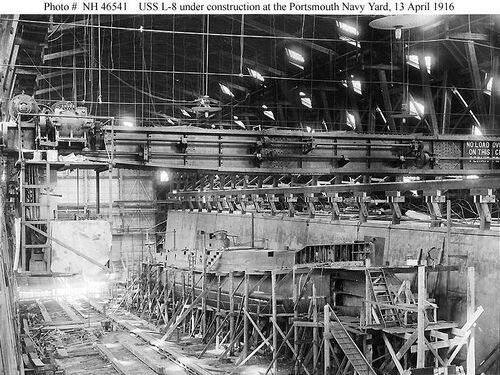
NHHC photo NH 46541 courtesy of the Naval History & Heritage Command.
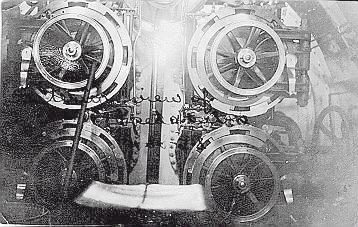
Photo from the private collection of Ric Hedman.

Photo from the private collection of Ric Hedman.
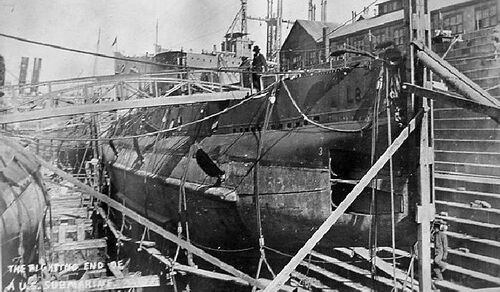
U.S. Navy photo.
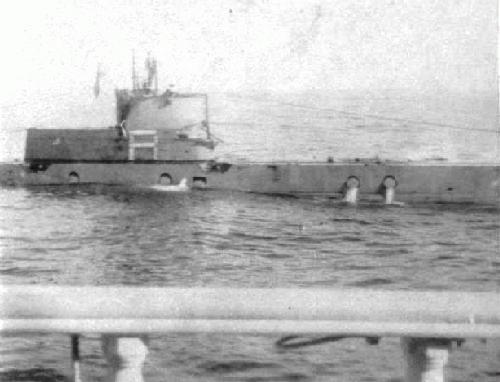
Photo contributed by Clifford Chapski. His grandfather, Alfred G. Benjamin, took this photo while serving aboard the USS Charles Whittemore.
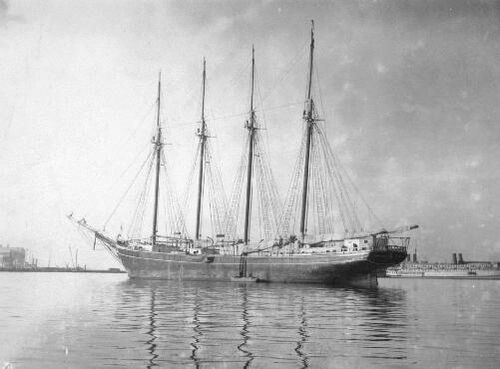
Photo contributed by Clifford Chapski. His grandfather, Alfred G. Benjamin, took this photo while serving aboard the USS Charles Whittemore.

L-8 ended its life as a target for tests of the new and highly secret Mk 6 magnetic exploder, later to gain infamy in WWII. For this test the Navy's Bureau of Ordnance took the ex-L-8 and moored her in Narragansett Bay off Newport, R.I. A Mk 8 torpedo equipped with a prototype of the new exploder was then fired from a barge. As can be seen from this May 26, 1926 aerial photo, the weapon passed directly underneath the sub, exactly as it was supposed to. However, the exploder failed to detect the boat's magnetic field and did not detonate the warhead. This should have been a warning that something was amiss. But the scientists and engineers on the development team and their leadership at the Bureau of Ordnance dismissed the failure as a fluke and they lined up for a second shot.
Photo NH 88457 courtesy of NHHC.
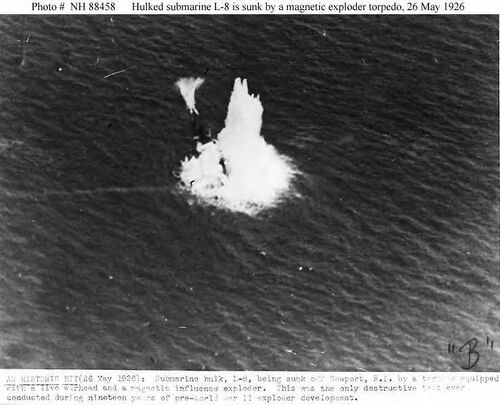
A short time after the first shot (shown above) the team was ready for another try on that fateful day of May 26, 1926. This time the shot was successful and the ex-L-8 was destroyed in a massive blast. The development team took this a proof that the concept worked and they pushed the Mk 6 exploder into production. No other at-sea testing was ever conducted at any location. Congratulating themselves on their brilliance and convinced of the perfection of their device based on this single test, the Mk 6 exploder was put into production and installed on all new Mk 13, 14 and 15 torpedoes produced at Newport. In actuality, the exploder had some serious technical flaws and it failed miserably in combat in WWII. It was a major factor in the near impotency of our submarines in the early days of the war.
Photo NH 88458 courtesy of NHHC.
Page created by:
Ric Hedman & David Johnston
1999 - 2023 - PigBoats.COM©
Mountlake Terrace, WA, Norfolk, VA
webmaster at pigboats dot com
